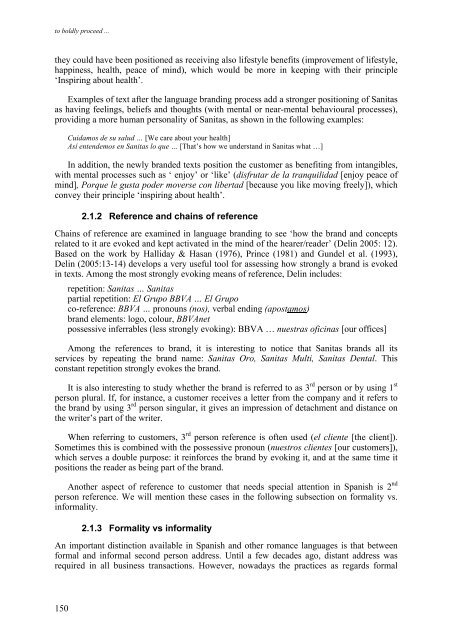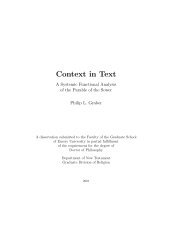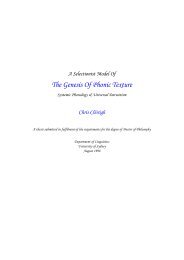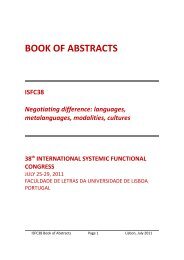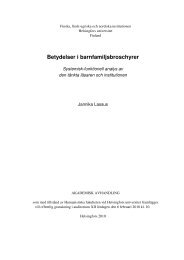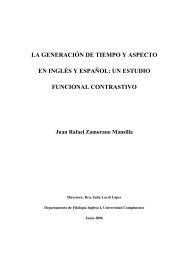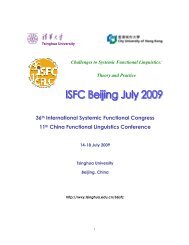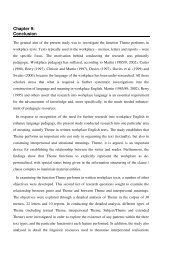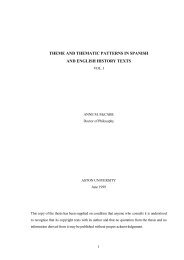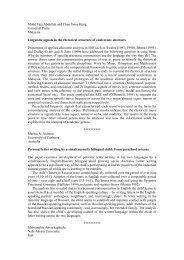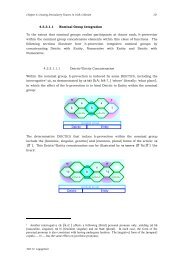to boldly proceed ...<strong>the</strong>y could have been positioned as receiving also lifestyle benefits (improvement of lifestyle,happiness, health, peace of mind), which would be more in keeping with <strong>the</strong>ir principle‘Inspiring about health’.Examples of text after <strong>the</strong> language branding process add a stronger positioning of Sanitasas having feelings, beliefs and thoughts (with mental or near-mental behavioural processes),providing a more human personality of Sanitas, as shown in <strong>the</strong> following examples:Cuidamos de su salud … [We care about your health]Así entendemos en Sanitas lo que … [That’s how we understand in Sanitas what …]In addition, <strong>the</strong> newly branded texts position <strong>the</strong> customer as benefiting from intangibles,with mental processes such as ‘ enjoy’ or ‘like’ (disfrutar de la tranquilidad [enjoy peace ofmind], Porque le gusta poder moverse con libertad [because you like moving freely]), whichconvey <strong>the</strong>ir principle ‘inspiring about health’.2.1.2 Reference and chains of referenceChains of reference are examined in language branding to see ‘how <strong>the</strong> brand and conceptsrelated to it are evoked and kept activated in <strong>the</strong> mind of <strong>the</strong> hearer/reader’ (Delin 2005: 12).Based on <strong>the</strong> work by Halliday & Hasan (1976), Prince (1981) and Gundel et al. (1993),Delin (2005:13-14) develops a very useful tool for assessing how strongly a brand is evokedin texts. Among <strong>the</strong> most strongly evoking means of reference, Delin includes:repetition: Sanitas … Sanitaspartial repetition: El Grupo BBVA … El Grupoco-reference: BBVA … pronouns (nos), verbal ending (apostamos)brand elements: logo, colour, BBVAnetpossessive inferrables (less strongly evoking): BBVA … nuestras oficinas [our offices]Among <strong>the</strong> references to brand, it is interesting to notice that Sanitas brands all itsservices by repeating <strong>the</strong> brand name: Sanitas Oro, Sanitas Multi, Sanitas Dental. Thisconstant repetition strongly evokes <strong>the</strong> brand.It is also interesting to study whe<strong>the</strong>r <strong>the</strong> brand is referred to as 3 rd person or by using 1 stperson plural. If, for instance, a customer receives a letter from <strong>the</strong> company and it refers to<strong>the</strong> brand by using 3 rd person singular, it gives an impression of detachment and distance on<strong>the</strong> writer’s part of <strong>the</strong> writer.When referring to customers, 3 rd person reference is often used (el cliente [<strong>the</strong> client]).Sometimes this is combined with <strong>the</strong> possessive pronoun (nuestros clientes [our customers]),which serves a double purpose: it reinforces <strong>the</strong> brand by evoking it, and at <strong>the</strong> same time itpositions <strong>the</strong> reader as being part of <strong>the</strong> brand.Ano<strong>the</strong>r aspect of reference to customer that needs special attention in Spanish is 2 ndperson reference. We will mention <strong>the</strong>se cases in <strong>the</strong> following subsection on formality vs.informality.2.1.3 Formality vs informalityAn important distinction available in Spanish and o<strong>the</strong>r romance languages is that betweenformal and informal second person address. Until a few decades ago, distant address wasrequired in all business transactions. However, nowadays <strong>the</strong> practices as regards formal150
Papers from <strong>the</strong> 39th ISFCdistance have changed and companies need to think carefully which form of address <strong>the</strong>ychoose to use. The choice will depend on <strong>the</strong> tenor as well as on <strong>the</strong> mode of each interaction.In <strong>the</strong> case of internal communications, <strong>the</strong> trend is for all communications to useinformal address (through <strong>the</strong> pronouns tú, vosotros and/or <strong>the</strong>ir corresponding verb endings)at all levels. For external communications <strong>the</strong> issue gets more complex, as <strong>the</strong> brand needs totake into account <strong>the</strong> customer and his/her potential reaction to each form of address.Customer’s age, ra<strong>the</strong>r than social status, is what tips <strong>the</strong> scales here. Younger customersprefer informal tú, while older customers would be offended by <strong>the</strong> ‘closeness’ implied ininformal tú and prefer formal address (usted). Mode also influences <strong>the</strong> choice betweenformal and informal address: webpages (which are a more modern means of communication)tend to use informal address with tú. Letters (and also emails) that are personalised (e.g.response to a request) can probably choose depending on <strong>the</strong> age of <strong>the</strong> customer. Telephonecontact through call centres will strongly go for formal address, as in <strong>the</strong> examples below:Si necesitara el número, se lo podemos facilitar [If you need <strong>the</strong> number, we can give it to you]Gracias a usted y enhorabuena [Thank you and congratulations]In <strong>the</strong>se two examples produced by an employee of Sanitas call centre as <strong>the</strong> finalexchanges in a conversation with a customer, we can see <strong>the</strong> use of formal address in <strong>the</strong>subjunctive verb form necesitara [‘need’ 2 nd p. sing. formal] in <strong>the</strong> first example, and <strong>the</strong>pronoun usted [‘you’ formal] in <strong>the</strong> second one. Notice also that <strong>the</strong> first example exhibitsreference to <strong>the</strong> brand through 1 st person plural verbal ending [podemos ‘we can’], an issuediscussed in section 2.1.2.2.1.4 Appraisal stanceBrands have obvious commercial purposes and, to achieve <strong>the</strong>ir aims, <strong>the</strong>y use attitudinallanguage. Part of <strong>the</strong> branding process often involves finding lexis that invokes <strong>the</strong> brandvalues. These values are usually positive ones and <strong>the</strong> lexis that expresses <strong>the</strong>m can often beanalysed as tokens of <strong>the</strong> Attitude and Graduation systems within Appraisal <strong>the</strong>ory (Martin &White, 2007). When looking at one of BBVA texts, for instance, we can see that two of <strong>the</strong>irbrand principles ‘leadership’ and ‘innovation’ are extremely positive words. Some of <strong>the</strong>branded language that BBVA uses includes clearly positive nouns such as pioneros [pioneer],calidad [quality], ventaja [advantage], innovación [innovation]. In addition, <strong>the</strong> adjectives<strong>the</strong>y use (nuevo [new], sólida [solid], fuerte [strong]), apart from being positive, are oftengraded, as in mejor [better], más completa [more complete], máximo [highest]. All of <strong>the</strong>sehelp position <strong>the</strong> brand as unique and differentiated from its competitors and indicate thatappraisal is an avenue worth exploring with regards to language branding.3 ConclusionsAlthough many brands have in <strong>the</strong> past paid attention only to <strong>the</strong>ir visual identity andneglected <strong>the</strong> way brand identity is expressed verbally, brands (and in particular servicebrands) cannot turn <strong>the</strong>ir backs on <strong>the</strong> potential that language offers for conveying <strong>the</strong>ir brandvalues. As shown in <strong>the</strong> literature, language branding can benefit from linguistics and, inparticular from <strong>the</strong> <strong>Systemic</strong> <strong>Functional</strong> Linguistics framework. This paper has followedDelin’s (2005) approach, and applied various aspects of SFL to Spanish corporatecommunications from two service brands in order to show how <strong>the</strong>se brands position<strong>the</strong>mselves and <strong>the</strong>ir customers. The areas explored and illustrated with Spanish examplesinclude transitivity, reference, formality vs. informality, and appraisal stance. All of <strong>the</strong>m arefruitful mechanisms for reinforcing brand values and brand positioning through language.151


